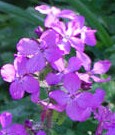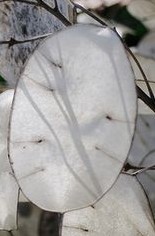 This biennial often grown as an annual is native to the Balkans and southwest Asia and is also called money plant, silver dollars, Chinese coins, and similar, because of its showy seedheads that are round and silvery. It is a member of the mustard family, Brassicaceae, that also includes cabbage, broccoli, and stock. Growing up to 12″ tall, the plant has large leaves that are oval, pointed and coarsely toothed. White to reddish-purple flowers are 1/2 across and borne in the late spring to early summer in terminal racemes. They are followed by flat, translucent seedpods that start out lime green but dry to silvery white. Each pod is one to three inches across and contains three or more seeds. Pods persist into the winter or can be cut for dried arrangements. Plants often reseed and naturalize where conditions are favorable. A good choice for cottage and woodland gardens. The genus name Lunaria, comes from the Latin word luna meaning moon and refers to the appearance of the seed pods. The specific epithet, annua, is the Latin word for annual.
This biennial often grown as an annual is native to the Balkans and southwest Asia and is also called money plant, silver dollars, Chinese coins, and similar, because of its showy seedheads that are round and silvery. It is a member of the mustard family, Brassicaceae, that also includes cabbage, broccoli, and stock. Growing up to 12″ tall, the plant has large leaves that are oval, pointed and coarsely toothed. White to reddish-purple flowers are 1/2 across and borne in the late spring to early summer in terminal racemes. They are followed by flat, translucent seedpods that start out lime green but dry to silvery white. Each pod is one to three inches across and contains three or more seeds. Pods persist into the winter or can be cut for dried arrangements. Plants often reseed and naturalize where conditions are favorable. A good choice for cottage and woodland gardens. The genus name Lunaria, comes from the Latin word luna meaning moon and refers to the appearance of the seed pods. The specific epithet, annua, is the Latin word for annual.
Type: Annual/biennial
 Bloom: White to purple flowers in terminal racemes, late spring to early summer
Bloom: White to purple flowers in terminal racemes, late spring to early summer
Size: 3’ h x 1’ W
Light: Part sun to part shade
Soil: Fertile, moist, well-drained
Hardiness: Zones 3-8
Care: Low maintenance
Pests and Diseases: Susceptible to clubroot, white blister, viruses, and leaf spot, but these are usually not a problem.
Propagation: Seed
Companion plants: Orange, pink, red or lavender tulips, common foxglove, Euphorbia polychroma, Euphorbia palustris
Outstanding Selections:
‘Munstead Puprle’
Lunaria annua var. albiflora (white flowers)
Lunaria annua var. ‘Alba Variegata’ (cream variegation and margins, white flowers).
